Abstract
Under the action of freeze–thaw cycles, the internal temperature and water distribution of slope soils in cold regions change significantly, which directly affects the stability of slopes. In order to study the differences in hydrothermal reactions at different depths and their impacts on the stability of slopes. This study establishes both a freeze–thaw model and a hydrothermal coupling model, combining field measurements with numerical simulations to examine the dynamic changes in hydrothermal characteristics within the slope. The results indicate that the variation in slope temperature with depth can be divided into three stages: initial freezing, stable freezing, and thawing. In the freezing stage, the negative temperature gradient drives water to migrate towards the freezing front, forming segregated ice and inducing frost heave. In the thawing stage, the latent heat released by the phase change in segregated ice promotes water to move towards the slope toe, increasing the water content there and indirectly exacerbating the risk of slope instability. The heat and moisture transfer in frozen soil slopes shows non-linear and dynamic characteristics. The unique process of one-way freezing and two-way thawing makes the thawing rate 1.35 times that of the freezing rate, and this asymmetric characteristic is the key to understanding the mechanism of slope instability.
1. Introduction
Cold regions are widely distributed in China. The soil in these areas is prone to frost heave and thaw settlement [1]. Freeze–thaw cycles can alter the pore structure of the soil [2,3], influence the expansion and contraction behavior of soil mass [4], cause soil deformation, and lead to a reduction in the strength of roadbeds and slopes under the action of environmental factors [5]. Moreover, the impact of freeze–thaw cycles on the hydrothermal process is particularly significant in permafrost regions [6]. Factors such as seasonal temperature fluctuations, snow and ice melting, and precipitation can cause remarkable changes in the temperature and moisture distribution in the soil. These changes directly affect the physical and mechanical properties of the soil, thus influencing the stability of slopes [7,8,9]. Therefore, it is of certain significance to study the water temperature characteristics in seasonally frozen soil regions under freeze–thaw cycles. In permafrost regions, as soil freezes, a temperature gradient develops between the cold and warm ends of the soil as external temperatures decrease [10,11]. When this temperature gradient is applied to the soil, unfrozen water migrates, transporting latent heat toward the freezing front. This process causes significant alterations in the soil’s thermal properties, which in turn have a profound effect on the temperature field [12,13]. Furthermore, it has been found that there is a specific response relationship between soil moisture content and temperature during the freeze–thaw process [12]. Following freeze–thaw cycles, the soil’s thermal conductivity decreases [14], and the factor of safety for slopes gradually diminishes with each successive freeze–thaw cycle [15].
In practical applications, certain data required for projects cannot be obtained through experiments, and the limited experimental results hinder a comprehensive understanding of the underlying physical mechanisms. Consequently, the development of mathematical models facilitates a more thorough understanding of these mechanisms and enables reasonable predictions and recommendations for engineering applications. The model proposed by Zhang et al. [16] effectively predicts the changes in thermal state and moisture content as the number of freeze–thaw cycles increases. Sun et al. [17] developed a hydrothermal–mechanical coupling model and computational methods to investigate and validate the spatial–temporal distribution of temperature, water, and mechanical fields under long-term freeze–thaw cycles. Furthermore, numerous studies [18,19,20] have utilized the PDE module for hydrothermal simulations or fluid–solid coupling, with results indicating minimal simulation errors and that the trends of simulated values for total soil moisture content and temperature closely match those of the measured data [21]. Zhou and Li [22] established a hydrothermal coupling model for frozen soil, revealing that the stepwise temperature variation over time reflects the water phase transition in the soil during the freezing process. In addition, Lai et al. [23] found that under hydrothermal coupling, the temperature gradient and cover pressure significantly influence the pore water pressure gradient, and that soil moisture content changes typically lag behind temperature variations. Liu et al. [24] observed that during unidirectional freezing, the freezing front in the soil column initially moves downward rapidly, with the freezing range gradually expanding over time. The rate of movement of the freezing front then decreases and stabilizes.
Previous studies have explored the impacts of the freeze–thaw process of frozen soil on the mechanical properties and stability of soil, and have also taken note of the hazards of the freeze–thaw process in slope areas. However, there are relatively few studies on analyzing the variation laws of the hydrothermal characteristics of frozen soil slopes at different depths through models and their specific influence mechanisms on slope stability. To deeply explore the different impacts of temperature changes on the freeze–thaw behavior of slopes, it is necessary to conduct research analyzing the hydrothermal characteristics of frozen soil based on models, studying the differential impacts of temperature changes on slopes, and analyzing the dynamic changes in temperature and water content in different freeze–thaw stages.
This study employs a hydrothermal coupling model to analyze the hydrothermal characteristics of frozen soil slopes, revealing the differential effects of temperature changes on slope behavior.
2. Materials and Methods
2.1. Freeze–Thaw Model
Seasonally frozen soils undergo repeated freezing and thawing processes due to cyclical climate change, and their water temperature coupling characteristics have a profound impact on soil structure and stability (see Figure 1). During the freezing stage, the lowering of air temperature leads to the formation of a frozen layer in the surface layer of the slope, and the transfer of heat to the deeper layers creates a significant temperature gradient, driving water to migrate to the freezing front and gather, forming a large number of ice crystals. The volume expansion of the ice crystals causes the frozen layer of soil to undergo frost deformation, resulting in the uplift of the surface layer of the slope, while the lower layer of soil suffers from localized water loss due to the migration of water, reducing the compactness of the soil and significantly weakening its mechanical properties. In the melting stage, as the temperature rises, the frozen layer gradually melts, and the ice crystals are transformed into liquid water and infiltrate along the slope structure to the foot of the left corner, increasing the saturation and looseness of the soil in the region. This process further weakens the strength of the soil at the toe of the slope and increases the risk of settlement and landslide. The mechanism of freezing water loss and thawing saturation in the freeze–thaw cycle of seasonally frozen soil not only exacerbates the structural disturbance caused by the soil water–heat migration and phase change effects, but also significantly increases the possibility of landslides and geohazards.
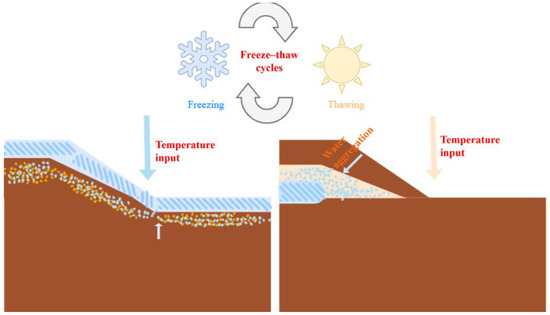
Figure 1.
Freeze–thaw process. (Freezing process indicated by snowflake, representing phase when soil cools and freezes; thawing process shown by sun, indicating phase when frozen soil warms up and melts.)
2.2. Coupled Permafrost Water–Heat Modeling
2.2.1. Basic Assumptions
The basic assumptions of the model are as follows: (1) The soil mass is a homogeneous, isotropic, linearly elastic material. (2) The compression and expansion of ice, water, and soil under the influence of freezing and thawing are neglected, and the density remains constant. (3) Water migration is based on the generalized Darcy law, which considers only liquid water and does not take into account the effects of gaseous water and salt migration. (4) Variations in the distribution of temperature and moisture content at the same depth are ignored.
2.2.2. Control Equations
- 1.
- Temperature control equation
If the effect of heat convection is neglected, the heat transfer equation considering the phase change is as follows:
where C is the volumetric integrated heat capacity of the material, L is the latent heat of phase change, is the density of the ice, and (%) is the volume content of pore ice.
- 2.
- Moisture control equation
- 3.
- Phase transition dynamic equilibrium relations
Referring to Bai [25], the empirical relationship between unfrozen water content and temperature was obtained through experiments; meanwhile, in order to simplify the modeling process, the concept of solid–liquid ratio is introduced to express the ratio of the volume content of unfrozen water and pore ice:
where represents the freezing temperature of the soil; B is the solid–liquid ratio, which represents the ice–water content volume ratio; and a is the ice content coefficient, which can be selected from empirical values to select the required parameters. The solid–liquid ratio is a segmented function that varies only with temperature, and a relational equation between pore ice and unfrozen water volume content can be established from the solid–liquid ratio, i.e., the following equation:
2.3. Parameters
2.3.1. Material Parameters
The soils in the test were taken from the landslide slopes along Madoi County, Qinghai Province, China. The soils were sandy gravel soils, according to JTG 3430-2020; Test Methods of Soils for Highway Engineering. Ministry of Transport of the People’s Republic of China: Beijing, China, 2020); a total of 15 sampling points were selected along three transects (upper, middle, and lower slope) at depths of 0–3 m, and the soil’s physical properties are listed in Table 1.

Table 1.
Material parameters of test red clay.
2.3.2. Model Parameters
- 1.
- Dynamic parameters
- Soil Volumetric Integrated Heat Capacity C:
- Thermal conductivity :
- The VG model of soil mass as the theoretical equation for solving the matrix suction of soil samples is as follows:
- Permeability coefficient :
- 2.
- Material parameters
The parameters selected in this paper were mainly determined comprehensively based on the typical empirical values specified in JGJ 118-2011; Code for Design of Building Foundation Soils in Frozen Soil Regions. China Architecture & Building Press: Beijing, China, 2012.and the data obtained from experiments by scholars such as Xu Xuezu [26]. The specific parameters used for this slope numerical calculation model are shown in Table 2 below.

Table 2.
Material parameters of side.
2.4. Model
Figure 2 shows the frozen soil slope model and its meshing. The upper-part initial boundary conditions of water content for the model were determined via the actual situation on-site. The specific functional form was obtained by fitting the measured water content on-site and some literature data [27,28,29]. The lower-part boundary of the water content field was set as a fixed water ratio, which was consistent with the initial water ratio of the foundation. The temperature boundaries included the top of the uphill slope, the slope surface, and the bottom of the slope. Their settings adopted the first-kind thermal boundary, and the specific functional form was determined by fitting the meteorological data of the Maduo area in the last three years and the measured data on-site. The size of the grid unit was extremely fine, and the meshing method was mapping.
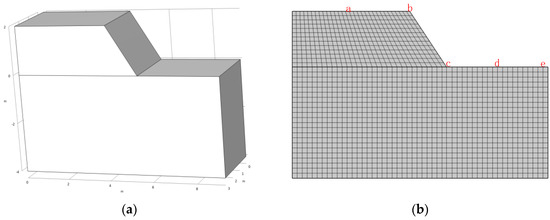
Figure 2.
Permafrost slope modeling. (a) Model (3D); (b) meshing (2D). (In (b), a is Top center of slope, b is Slope top, c is Bottom of slope, d is Bottom center of slope, e is Right end of slope bottom).
3. Results and Discussion
3.1. Model Verification
Figure 3 shows the comparison results of the measured and simulated values of temperature changes with depth during January, February, and March [16]. From the overall trend, the change laws of the measured curves and the simulated curves in different months are consistent, all showing that the temperature tends to be stable as the depth increases. This indicates that the model has high accuracy in capturing the law of soil liquid temperature changes with depth, especially under the winter conditions of January and February, where the simulation results match well with the measured data, verifying the adaptability of the model to the heat transfer process in low-temperature environments. However, in March, the simulated values of the shallow layer (regional surface layer humidity changes) are slightly lower than the measured values. This may be related to the rapid surface temperature rise and the characteristics of cover materials (such as snow melting and surface layer humidity changes) not being fully considered. Neglecting the snowmelt process may lead to inaccuracies in the thermal boundary conditions of the surface layer of frozen soil, causing the model to overestimate the stability of the frozen soil. In reality, when the snow cover melts, the ground surface turns into bare soil with a low albedo, enhancing its heat absorption capacity, which results in the simulated temperature being lower than the measured temperature. Furthermore, failing to consider the regulatory effects of precipitation, surface runoff, and snowmelt water on the distribution of surface humidity can lead to the accumulation of water at the freeze–thaw interface, forming ice lenses. These ice lenses release latent heat, slowing down the cooling of the frozen layer. This situation may cause an underestimation of the temperature of the frozen soil, making the simulated values lower than the measured ones. This discrepancy echoes findings by Fu Q et al. [12], who emphasized the insulating role of snow cover in delaying thawing processes. Compared to Zhou J’s [22] phase-lag model, our framework better resolves latent heat release during ice–water transitions, particularly in shallow layers, where pore water phase changes dominate thermal responses. Overall, the model can accurately simulate the winter soil liquid temperature distribution, but there are limitations in representing the dynamic thermal process of the surface layer in spring. Further improvements are needed to enhance the model’s ability to describe the hydrothermal coupling mechanism under complex climate changes.

Figure 3.
Comparison of simulated and measured soil liquid temperatures in different months. (a) January; (b) February; (c) March.
Figure 4 shows the comparison between the simulated and measured values of soil liquid water content during January, February, and March [16]. The results show that the model can relatively accurately reflect the general trend that the water content gradually decreases with increasing depth. At the same time, it reveals significant seasonal changes in water content distribution in different months. Specifically, in shallow-layer soil, water content fluctuations are more obvious due to the greater influence of external climate factors (such as evaporation and precipitation), and there is a certain deviation between the simulated values and the measured values. In deep-layer soil (>2 m), the water content change tends to be stable, and the degree of fitting between the simulated values and the measured values is relatively high, indicating that the model can accurately capture the deep-layer water migration law. As time passes, the degree of matching between the simulation results and the measured data are further improved, verifying the applicability and stability of the model in describing the spatio-temporal distribution and dynamic change process of soil water content, and providing support for research on the influence of freeze–thaw cycles on soil water characteristics.

Figure 4.
Comparison of simulated and measured soil liquid water content in different months. (a) January; (b) February; (c) March.
3.2. Long-Term Water Temperature Characteristics
Figure 5 reflects the temperature change characteristics of the slope top and different depths (1 m, 2 m) and the foundation center, reflecting the hydrothermal coupling thermodynamic response mechanism of the soil under long-term freeze–thaw cycles. The temperature of shallow-layer soil shows significant periodic fluctuations, and the fluctuation amplitude gradually decreases with the increase in depth, accompanied by a certain phase-lag phenomenon. This characteristic indicates that the shallow-layer soil is more significantly affected by seasonal freeze–thaw cycles. Frequent temperature fluctuations lead to the alternating freezing and thawing of soil pore water, thereby affecting the soil’s hydrothermal balance and structural stability. In comparison, the temperature change amplitude of the foundation center is significantly reduced, showing higher thermal stability. Due to the thermal diffusion effect, deep-layer soil has an obvious buffering effect from external temperature fluctuations, thereby weakening the impact of freeze–thaw cycles on the soil. This thermal diffusion effect is closely related to the soil’s thermal conductivity coefficient, heat capacity, and depth, further revealing the complexity of soil hydrothermal conduction.
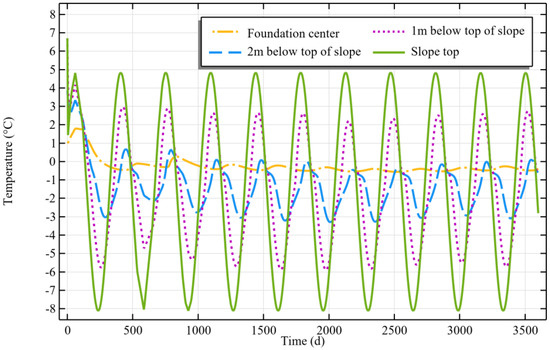
Figure 5.
Slope and foundation temperature variation.
Figure 6 shows the long-term dynamic change law of soil water content with time at different locations, reflecting the significant influence of climate change on soil water migration. The water content in the figure shows obvious periodic fluctuations [with a period of about one year], and there are significant differences in fluctuation amplitudes and phases [12]. Among them, the water content at the top of the slope has the largest fluctuation amplitude, with the lowest value close to 0.08% and the highest value exceeding 0.28%, indicating that the top of the slope is exposed to climate conditions (such as precipitation and evaporation) and is the location with the most drastic water changes. The fluctuation amplitudes of water content at 1 m and 2 m below the top of the slope gradually decrease with the increase in depth, and there is an obvious phase lag, reflecting the influence of soil permeability and hydrodynamic effects on the process of water permeating from the surface to the deep layer. In comparison, the fluctuation amplitude of water content at the center of the foundation is the smallest, about 0.26–0.30%, and the water change is relatively stable, which may be controlled by the groundwater level and lower permeability. The large-amplitude fluctuations in the slope area indicate that it is more sensitive to environmental changes and may become a potential instability factor [12], while the relatively stable water content at the center of the foundation provides safe foundation conditions. In addition, the depth-lag effect of the fluctuations further reveals the time-response characteristics of water migration. Therefore, the accumulation of moisture at the slope toe during both freezing and thawing stages poses a critical risk of collapse. These findings directly inform engineering practices: the real-time monitoring of pore water content at depths of −2–0 m could serve as an early warning indicator for instability and provide a dynamic assessment of seasonal risks, essential for infrastructure design in permafrost regions.
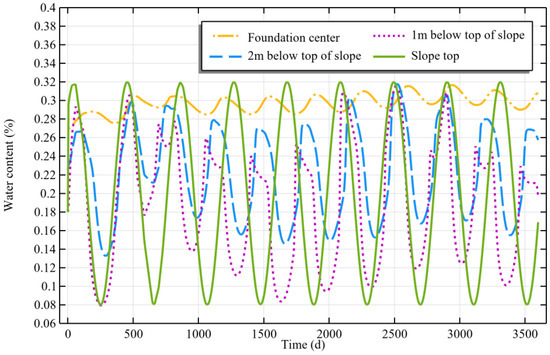
Figure 6.
Changes in water content of slopes and foundations.
In summary, the hydrothermal coupling mechanism plays a central role in the soil freeze–thaw cycle. It drives the phase change and migration of water through temperature changes, thereby affecting the thermodynamic properties and structural stability of the soil. Shallow-layer soil is directly affected by external climate conditions, with significant temperature fluctuations, resulting in the frequent freezing and thawing of pore water, triggering water migration and soil expansion and contraction, thus exacerbating soil instability. In comparison, deep-layer soil shows higher thermal stability due to the thermal diffusion effect, and the decrease in temperature gradient inhibits water migration, resulting in relatively stable water changes. This hydrothermal interaction not only reveals the depth-lag effect of temperature and water migration but also emphasizes the dual influence of hydrothermal coupling on soil stability: shallow-layer soil is easily damaged by freeze–thaw cycles, while deep-layer soil provides relatively stable conditions for engineering foundations.
The temperature variation with depth at different freeze–thaw cycle counts, as shown in Figure 7, is divided into three stages: early freezing (a), stable freezing (b), and thawing (c). During the early freezing stage, the temperature drops rapidly, with the surface layer beginning to freeze, and the temperature gradient is relatively large. In the stable freezing stage, the temperature levels off, the freezing layer reaches its maximum depth, and the heat conduction rate slows down. During the thawing stage, the temperature gradually rises, and heat is transferred from the surface to deeper layers, causing the frozen layer to melt progressively. Additionally, the figure illustrates the suppressive effect of phase change latent heat on temperature variation, the depth-lag effect in temperature changes, and the potential impact of freeze–thaw cycles on soil moisture content [11].
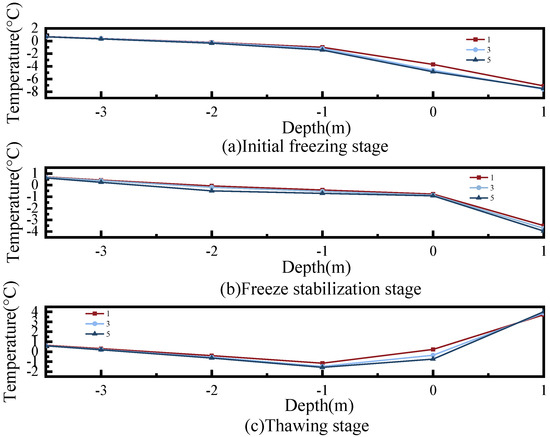
Figure 7.
The temperature profiles at the center of the slope at different freeze–thaw stages.
Figure 8 shows the soil moisture content profiles at different freeze–thaw cycle counts and stages. In panel (a), representing the early freezing stage, the moisture content increases gradually with depth, starting from nearly 0% at the top (2 m deep) and reaching about 0.28% at the bottom (−3 m deep). This phenomenon can be attributed to the initial freezing of moisture at the surface due to exposure to low temperatures, resulting in a low moisture content near the surface. In contrast, the bottom region experiences a delayed freezing process due to the lag in heat transfer, maintaining a relatively higher moisture content. Panel (b) shows the stable freezing stage, where the curve demonstrates a gradual change from approximately 0.10% moisture content at 2 m depth to about 0.30% at −3 m depth. This stage indicates that thermal and moisture migration within the system have reached a relatively stable equilibrium, with the moisture content variations between different depths significantly reduced, resulting in a more stable distribution. Panel (c), representing the thawing stage, shows a more complex curve. Starting from about 0.12% moisture content at 2 m depth, the curve initially rises, forming a small peak of around 0.24% near the 0-m depth, and then gradually decreases to about 0.27% at −3 m depth. This complex variation reflects the interplay of several factors, such as the uneven temperature gradient and moisture redistribution during the thawing process, leading to non-monotonic changes in moisture content at different depths and significant peak fluctuations at specific depths [3].
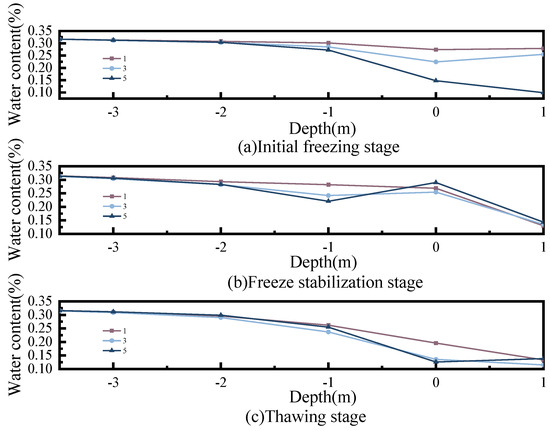
Figure 8.
The moisture content profiles at the center of the slope in different freeze–thaw stages.
3.3. Freeze–Thaw Water Temperature Characteristics
As shown in Figure 9, the freeze–thaw process of seasonal frozen soil slopes exhibits distinct stages and asymmetric rates. Taking one cycle as an example, the freezing process (dashed line) begins at 0 days and reaches a maximum depth of 0.98 m by day 215 of the following year. During the early stage, the freezing depth increases rapidly, indicating that the temperature drops quickly and the surface temperature falls below the freezing point, allowing cooling energy to transfer to the ground. In the later stages, the freezing depth growth slows, which is attributed to the reduced temperature difference between the surface and the deeper soil as freezing deepens, thus decreasing the efficiency of heat transfer. During the thawing process, the upper surface layer melts rapidly in the early stage, indicating a significant rise in air temperature and a faster melting rate. In the later stage, the lower soil layer’s melting depth increases more slowly, likely due to a reduction in surface heat input or slower heat diffusion to deeper soil layers. Unlike permafrost, where freeze–thaw cycles are mainly influenced by surface temperature, seasonal frozen soil is affected by both surface temperature and underground heat flux. The process exhibits characteristics of unidirectional freezing (i.e., shallow soil begins to freeze from the surface downward) and bidirectional thawing (i.e., thawing occurs from the surface downward and from the bottom of the frozen layer upward), with the melting rate significantly higher than the freezing rate. During the thawing process, the primary thawing occurs in the shallow soil layers. Overall, the freezing process lasts approximately 1.35 times longer than the thawing process, and the thawing rate is notably higher than the freezing rate. This reflects the characteristics of unidirectional freezing and bidirectional thawing in seasonal frozen soil, with thawing being more sensitive to changes in surface temperature.
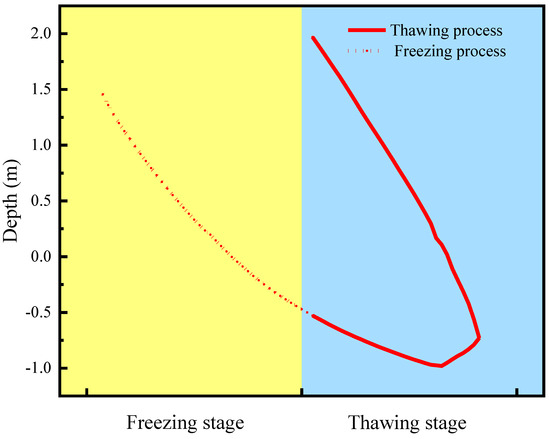
Figure 9.
Depth of central freeze–thaw front.
Figure 10 illustrates the temperature variation with depth at different freeze–thaw stages of the slope. During the freeze–thaw process, the temperature of the slope changes significantly. In the early freezing stage, the surface temperature rapidly drops to near 0 °C, while the deeper layers remain relatively stable, exhibiting a clear temperature gradient. In the stable freezing stage, the environment continues to cool, with the surface temperature dropping to a stable negative value. The deeper layers are also affected, and the gradient diminishes. In the thawing stage, the surface layer quickly rises to positive temperatures, while the deeper layers change more slowly and remain below zero, leading to a reduced overall temperature gradient. The temperature changes at different locations are influenced by topography, thermal conductivity, and ambient temperature, with the shallow layers being more sensitive to changes and the deep layers exhibiting a delayed response and smaller amplitude.

Figure 10.
Temperature variation with depth at different freeze–thaw stages of slope. (a) Initial freezing stage; (b) freeze stabilization stage; (c) thawing stage.
In the early freezing stage, the surface loses heat due to contact with cold air, creating a temperature gradient within the slope, with heat transferring from the deeper to the shallower layers. Although soil moisture freezes and releases latent heat, the rapid cooling prevents uniform heat diffusion. Additionally, the formation of ice increases the soil’s thermal conductivity, causing the temperature to drop rapidly with depth, especially in the shallow layers. During the stable freezing stage, the heat loss and the latent heat released during water freezing reach a balance, and the thermal conductivity of the ice–soil system stabilizes, leading to a reduced temperature variation. In the thawing stage, the warming of the surface causes soil ice to melt and absorb heat, with heat transferring to deeper layers. However, the deep layers warm more slowly, resulting in a gradual decrease in temperature with depth.
Figure 11 shows the variation in moisture content with depth at different freeze–thaw stages of the slope. In the early freezing stage, the surface layer experiences a sharp decrease in moisture content due to the freezing and migration of water caused by low temperatures. The middle layer shows a smaller change with a reduced gradient, as the temperature effects are delayed. The deep layer remains relatively unchanged due to slower heat transfer and good thermal insulation. During the stable freezing stage, the surface layer undergoes minimal changes as most of the moisture freezes or reaches a stable mixed state. The middle layer stabilizes after adjustment, with little fluctuation in temperature. The deep layer remains unaffected by external influences and maintains its original state. In the thawing stage, the surface layer experiences a sharp increase in moisture content due to the melting of ice and gravity-driven infiltration [3]. The middle layer shows delayed changes with smaller amplitudes, as heat transfer is slower and the amount of ice is lower. The deep layer experiences the smallest changes due to slower heat transfer and gradual warming.

Figure 11.
Variation in moisture content with depth at different freeze–thaw stages of slope. (a) Initial freezing stage; (b) freeze stabilization stage; (c) thawing stage.
The variation in maximum ice content and its corresponding temperature during the freeze–thaw process of frozen soil slopes is illustrated in Figure 12. From the figure, it is evident that during the freezing stage, as the temperature decreases, water gradually transitions from liquid to solid, forming ice crystals, which leads to an increase in the ice content of the soil. The advancement of the freezing front is accompanied by the accumulation of ice, causing the ice content in the frozen region to continue rising. Simultaneously, the volume expansion of ice induces frost heaving, which leads to the migration of pore water toward the freezing front or infiltration into the unfrozen areas. In contrast, the thawing stage exhibits an opposite trend: as the temperature increases, the ice begins to melt, and the ice content gradually decreases. The meltwater redistributes and infiltrates into other parts of the soil, with the ice content significantly reduced toward the end of the thawing process, approaching zero or the minimum value, indicating that the ice has fully melted, leaving only liquid water distributed within the pores. The bar chart further quantitatively analyzes the variation in maximum ice content, with the freezing stage showing a significant accumulation of ice, while the thawing stage shows a gradual loss of ice. This process may be accompanied by soil subsidence, leading to a significant reduction in soil strength. Overall, Figure 12 reveals the complex coupling relationship between temperature variations, latent heat release during phase changes, heat transfer, and the dynamic distribution of ice content during the freezing and thawing processes.
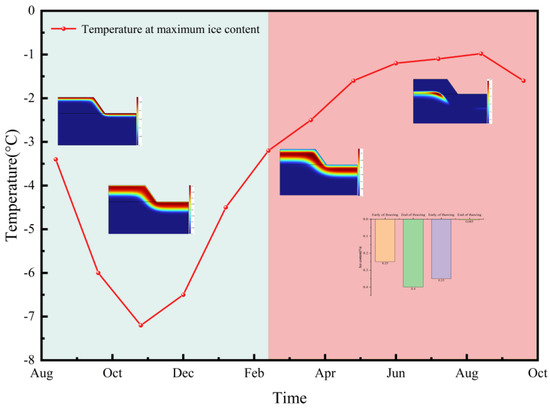
Figure 12.
Variation in ice content and temperature in slope.
4. Conclusions
This study investigates the thermal and moisture characteristics of frozen soil during freeze–thaw cycles. By combining experimental data and numerical simulations, it reveals the distribution patterns of the temperature field, moisture migration, ice–water phase change mechanisms, and the indirect impact of water temperature changes on slope stability under freeze–thaw conditions. The study finds the following observations:
- During the freezing stage, the negative temperature gradient causes the water inside the slope to migrate towards the freezing front, thereby inducing the formation of segregated ice and the occurrence of frost heave. In the thawing stage, the latent heat released by the melting of segregated ice triggers the migration of water inside the slope towards the toe of the slope. Since there is a potential trend of increased water content at the toe of the slope during both the frost heave and thawing stages, this indirectly increases the risk of slope toe collapse and instability.
- Under the action of freeze–thaw cycles, the variation in temperature with depth inside the slope can be divided into three stages, namely the initial freezing stage, the stable freezing stage, and the thawing stage.
- In the initial freezing stage, the water content of the slope soil from −3 m to −1 m is relatively stable, and the number of freeze–thaw cycles has no significant impact on it. The difference in water content of the slope soil from −1 m to 1 m gradually becomes apparent. When entering the stable freezing stage, the soil from −3 m to −2 m is in a relatively stable frozen state, and the number of freeze–thaw cycles has a relatively limited impact on its water content. However, the water content of the soil at a depth of −2 m to 0 m is redistributed. In the thawing stage, for the soil at a depth of −3 m to 0 m, the greater the number of freeze–thaw cycles, the larger the difference in water content.
- The distribution of heat and water transfer inside the frozen soil slope with depth exhibits non-linear and dynamic characteristics. At the same time, there are differences between frozen soil slopes and frozen soil subgrades. Frozen soil slopes are characterized by one-way freezing, two-way thawing, and a thawing rate higher than the freezing rate. This is the key to understanding the mechanism of slope instability.
The model proposed in this study provides a new framework for analyzing deeply- related hydrothermal coupling. The proposed framework outperforms existing unidirectional models by resolving latent heat effects and bidirectional thawing, offering a robust tool for slope risk assessment. However, its applicability is limited by the assumption of simplified soil homogeneity. Future work should incorporate particle heterogeneity and the effects of organic matter to improve the prediction accuracy of natural slopes.
Author Contributions
Conceptualization, F.D. and B.T.; Methodology, L.Q.; Software, L.Q. and H.W.; Validation, L.Q.; Formal analysis, F.D. and B.T.; Investigation, F.D. and H.W.; Resources, F.D.; Data curation, H.W.; Writing—original draft, F.D. and B.T.; Writing—review & editing, F.D., L.Q., H.W. and B.T.; Supervision, B.T. All authors have read and agreed to the published version of the manuscript.
Funding
This research received no external funding.
Institutional Review Board Statement
Not applicable.
Informed Consent Statement
Not applicable.
Data Availability Statement
The original contributions presented in the study are included in the article, further inquiries can be directed to the corresponding author.
Acknowledgments
This work was supported by College of Civil Engineering of Chongqing Jiaotong University The authors express their sincere gratitude for the experimental platform provided.
Conflicts of Interest
The authors declare no conflict of interest.
References
- Chen, H.; Gao, X.; Wang, Q. Research progress and prospect of frozen soil engineering disasters. Cold Reg. Sci. Technol. 2023, 212, 103901. [Google Scholar] [CrossRef]
- Shen, J.; Wang, Q.; Chen, Y.; Han, Y.; Zhang, X.; Liu, Y. Evolution process of the microstructure of saline soil with different compaction degrees during freeze-thaw cycles. Eng. Geol. 2022, 304, 106699. [Google Scholar] [CrossRef]
- Zhang, Z.-L.; Cui, Z.-D. Analysis of microscopic pore structures of the silty clay before and after freezing–thawing under the subway vibration loading. Environ. Earth Sci. 2017, 76, 528. [Google Scholar] [CrossRef]
- Wei, Y.; Tang, C.S.; Zhu, C.; Cheng, Q.; Lu, Y.; Li, L.; Tian, B.G.; Shi, B. Influence of desiccation during freeze-thaw cycles on volumetric shrinkage and tensile strength of compacted clayey soils. Eng. Geol. 2024, 334, 107513. [Google Scholar] [CrossRef]
- Kong, J.; Zhuang, J.; Peng, J.; Ma, P.; Zhan, J.; Mu, J.; Wang, J.; Zhang, D.; Zheng, J.; Fu, Y.; et al. Failure mechanism and movement process of three loess landslides due to freeze-thaw cycle in the Fangtai village, Yongjing County, Chinese Loess Plateau. Eng. Geol. 2023, 315, 107030. [Google Scholar] [CrossRef]
- Chen, Q.; Liu, Y.; Wang, Y.; Su, L.; Cheng, Y. Investigation of coupled thermo-hydro-mechanical processes on soil slopes in seasonally frozen regions. Cold Reg. Sci. Technol. 2025, 229, 104356. [Google Scholar] [CrossRef]
- Wang, T.; Jia, H.; Sun, Q.; Li, G. Effect of the frozen layer on the stability of cut soil slopes during seasonal freezing and thawing. Res. Cold Arid. Reg. 2022, 14, 281–292. [Google Scholar] [CrossRef]
- Korshunov, A.A.; Doroshenko, S.P.; Nevzorov, A.L. The impact of freezing-thawing process on slope stability of earth structure in cold climate. Procedia Eng. 2016, 143, 682–688. [Google Scholar] [CrossRef]
- Li, D.; Wen, Z.; Luo, J.; Zhang, M.; Chen, B. Slope failure induced by cold snap and continuous precipitation in the seasonal frozen area of Qinghai-Tibet Plateau. Sci. Total Environ. 2019, 694, 133547. [Google Scholar] [CrossRef]
- Wen, Z.; Zhang, M.; Ma, W.; Wu, Q.; Niu, F.; Yu, Q.; Fan, Z.; Sun, Z. Thermal–moisture dynamics of embankments with asphalt pavement in permafrost regions of central Tibetan Plateau. Eur. J. Environ. Civ. Eng. 2015, 19, 387–399. [Google Scholar] [CrossRef]
- Zhang, M.; Zhang, X.; Lai, Y.; Lu, J.; Wang, C. Variations of the temperatures and volumetric unfrozen water contents of fine-grained soils during a freezing–thawing process. Acta Geotech. 2020, 15, 595–601. [Google Scholar] [CrossRef]
- Fu, Q.; Hou, R.; Li, T.; Jiang, R.; Yan, P.; Ma, Z.; Zhou, Z. Effects of soil water and heat relationship under various snow cover during freezing-thawing periods in Songnen Plain, China. Sci. Rep. 2018, 8, 1325. [Google Scholar] [CrossRef] [PubMed]
- Xu, X.; Zhang, W.; Wang, Y. Measuring and modeling the dielectric constant of soil during freezing and thawing processes: An application on silty clay. Acta Geotech. 2022, 17, 3867–3886. [Google Scholar] [CrossRef]
- Cheng, P.; Luo, K.Q. Study on influencing factors and prediction of silty soil thermal conductivity in seasonal frozen area. Sci. Technol. Eng. 2016, 16, 235–239. [Google Scholar]
- Liu, N.; Yang, Y.; Li, N.; Liang, S.; Liu, H.; Li, C. The stability issue of fractured rock mass slope under the influences of freeze–thaw cycle. Sci. Rep. 2024, 14, 5674. [Google Scholar] [CrossRef]
- Zhang, C.; Liu, E.; Wei, X.; Yin, X.; Xiao, W.; Yu, D.; He, C. Experimental study and numerical modeling of the thermo-hydro-mechanical process in unsaturated soil under freeze-thaw cycles. Cold Reg. Sci. Technol. 2024, 218, 104063. [Google Scholar] [CrossRef]
- Sun, K.; Jia, J.; Xiong, Z.; Wu, J.; Liu, Y.; Wei, Y. Investigation of hydro-thermal variations and mechanical properties in cold region tunnels under long-term freeze–thaw cycles. Tunn. Undergr. Space Technol. 2024, 143, 105469. [Google Scholar] [CrossRef]
- Zhang, W.; Shen, Z.; Ren, J.; Gan, L.; Wang, F.; Yu, B.; Li, C. Modeling and comparative analysis of a flow and heat coupling model of the riparian zone based on thermal conductivity empirical models. J. Hydrol. 2020, 582, 124539. [Google Scholar] [CrossRef]
- Li, P.; Yue, F.; Wang, K.; Zhang, H.; Huang, H.; Kong, X. Fully coupled thermo-hydro-mechanical modeling and simulation of a fluid-saturated porous medium under local thermal non-equilibrium condition. Int. J. Heat Mass Transf. 2022, 195, 123195. [Google Scholar] [CrossRef]
- Rui, D.-H.; Lu, M.; Watanabe, K.; Zhang, J. The analysis of heat and water fluxes in frozen silty soil. Sci. Cold Arid. Reg. 2019, 11, 1. [Google Scholar]
- Wang, Z.; Fu, Q.; Jiang, Q.; Li, T. Numerical simulation of water–heat coupled movements in seasonal frozen soil. Math. Comput. Model. 2011, 54, 970–975. [Google Scholar] [CrossRef]
- Zhou, J.; Li, D. Numerical analysis of coupled water, heat and stress in saturated freezing soil. Cold Reg. Sci. Technol. 2012, 72, 43–49. [Google Scholar] [CrossRef]
- Lai, Y.; Pei, W.; Zhang, M.; Zhou, J. Study on theory model of hydro-thermal–mechanical interaction process in saturated freezing silty soil. Int. J. Heat Mass Transf. 2014, 78, 805–819. [Google Scholar] [CrossRef]
- Liu, F.; Jiao, X.; Wang, S.; Zhong, L.; An, P. Heat, water and vapor coupled migration in loess under uniaxial freezing condition. Cold Reg. Sci. Technol. 2022, 198, 103550. [Google Scholar] [CrossRef]
- Bai, Q.B.; Li, X.; Tian, Y.H.; Fang, J.H. Equations and numerical simulation for coupled water and heat transfer in frozen soil. Chin. J. Geotech. Eng. 2015, 37 (Suppl. S2), 131–136. [Google Scholar]
- Xu, X.-Z.; Wang, J.-C.; Zhang, L.-X. Physics of Frozen Soils, 2nd ed.; Science Press: Beijing, China, 2010; pp. 1–38. [Google Scholar]
- Chen, H.-C.; Li, X.-D.; Li, F.-X.; Zhou, B.-R.; Li, C.-Y. Change of Soil Temperature and Soil Moisture Content in Typical Degenerated Steppe in Maduo County in the Headstream Region of the Yellow River. Arid. Zone Res. 2013, 30, 35–40. [Google Scholar]
- Shi, F.; Qin, J.; Han, T.; Sun, Y.; Yang, B.; Fu, X. Variation and characteristics of soil hydrological elements in the source region of the Yellow River. Prog. Geogr. 2023, 42, 1691–1703. [Google Scholar] [CrossRef]
- Gao, W.; Sun, W.; Wang, X.; Dong, N. (Eds.) Moisture Content Distribution and Variation Law of Highway Subgrade in High-Latitude and Low-Altitude Deep Seasonal Frozen Ground Region. In IOP Conference Series: Earth and Environmental Science; IOP Publishing: Bristol, UK, 2021. [Google Scholar]
Disclaimer/Publisher’s Note: The statements, opinions and data contained in all publications are solely those of the individual author(s) and contributor(s) and not of MDPI and/or the editor(s). MDPI and/or the editor(s) disclaim responsibility for any injury to people or property resulting from any ideas, methods, instructions or products referred to in the content. |
© 2025 by the authors. Licensee MDPI, Basel, Switzerland. This article is an open access article distributed under the terms and conditions of the Creative Commons Attribution (CC BY) license (https://creativecommons.org/licenses/by/4.0/).